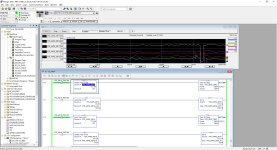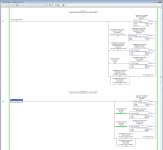trueninjalo
Lifetime Supporting Member
I am trying to find the operating limit range of a few conveyors. In the event one of them breaks I want to see the abnormal value and use this for an alarm trigger. For example, conveyor SB19 is running at 1.29-1.3 amp when it is empty, and its peak seems to be 1.4 amps (so far) when loaded. The lowest value so far while running was 1.29.
I have made some what of a band pass filter in the logic and I would like to refine it. When the conveyor stopped I got a low value of 1.28 amps. While this isn't a big difference it still isn't accurately representing the situation. However, the line may actually go this low while running so I don't want to ignore this value.
Please review the photo and let me know if there is a better way to go about this. For the low filter I watched the lowest value for about 30 minutes and subtracted 5 (which gave me 125) and made this my low monitor limit. If the line stops then value drops to 0 in less than a second (no ramps). I did the opposite for the high filter.
Background: A conveyor broke and the start stop sequence didn't stop the line properly. The photo eyes weren't covered properly to trigger the jammed state, and the stop cascade never triggered. My first thought was to create an activity monitor for all conveyors and if downstream conveyors have no activity while upstream do, then trigger a blocked state. This however wont stop the line fast enough so monitoring the VFD current seemed like a better way to catch it.
Thanks for any assistance.

I have made some what of a band pass filter in the logic and I would like to refine it. When the conveyor stopped I got a low value of 1.28 amps. While this isn't a big difference it still isn't accurately representing the situation. However, the line may actually go this low while running so I don't want to ignore this value.
Please review the photo and let me know if there is a better way to go about this. For the low filter I watched the lowest value for about 30 minutes and subtracted 5 (which gave me 125) and made this my low monitor limit. If the line stops then value drops to 0 in less than a second (no ramps). I did the opposite for the high filter.
Background: A conveyor broke and the start stop sequence didn't stop the line properly. The photo eyes weren't covered properly to trigger the jammed state, and the stop cascade never triggered. My first thought was to create an activity monitor for all conveyors and if downstream conveyors have no activity while upstream do, then trigger a blocked state. This however wont stop the line fast enough so monitoring the VFD current seemed like a better way to catch it.
Thanks for any assistance.






